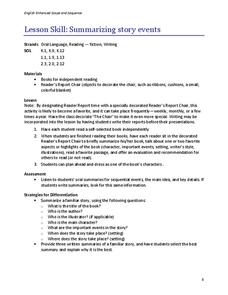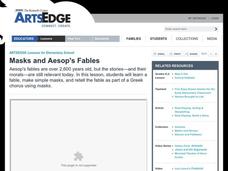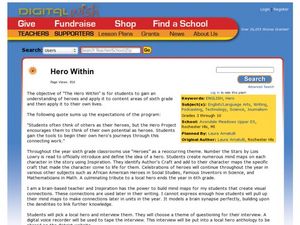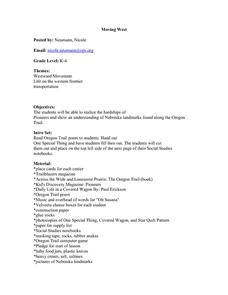Curated OER
Summarizing Story Events
Here is a way to build your pupils' public speaking abilities. The lesson plan describes a reader's report chair, which is used each week by a student who has just finished reading a book. The featured reader sits in the chair and talks...
Curated OER
Question Cards for Reading
Sometimes a teacher reading to a child doesn't think to stop to ask questions about the text. For those of us who don't engage the learners during reading activities, here is a set of cards that contain the questions all teachers need to...
Curated OER
A Friend Is...
Students investigate characteristics of friendship through literature and interviews then share their ideas through posters. They role play scenarios related to friends and problems they might have. This lesson reflects cross curricular...
Curated OER
Masks and Aesop's Fables
Students study and perform Aesop's fables. In this Aesop's fables lesson, students read and/or listen to a number of the famous fables. They make masks based on the characters and perform a fable using the masks. They write about the...
Curated OER
Literature-based Skill Building: Holes by Louis Sachar: Chapter 24
In this literature response learning exercise, students answer 12 short essay questions about the vocabulary, characters and quotations in Chapter 25 of Holes by Louis Sachar.
Curated OER
Literature-based Skill Building: Holes by Louis Sachar Chapter 14
In this literature response instructional activity, learners answer 20 short essay questions about Chapter 14 of the book called Holes by Louis Sachar.
Curated OER
Literature-based Skill Building: Holes by Louis Sachar (Chapter 39)
In this literature response worksheet, students answer 20 short essay questions about Chapters 39-44 of the book Holes by Louis Sachar.
Curated OER
Literature-based Skill Building: Holes by Louis Sachar
In this literature response worksheet, students answer 7 essay questions about Chapter 11 of the book called Holes by Louis Sachar.
Missouri Department of Elementary
Are You Balanced?
Balance scales create a strong visual of how an individual prioritizes one's self alongside their commitments to the community, school, and home. Scholars complete a graphic organizer then discuss their findings with their peers. A...
Reed Novel Studies
Surviving the Applewhites: Novel Study
The Bradys, the Flintstones, and the Simpsons are some of pop culture's most memorable families. So how do the Applewhites stack up? Using a novel study for Surviving the Applewhites by Stephanie S. Tolan, scholars answer text-based...
Curated OER
Where the Red Fern Grows Chapter 7 Worksheet
Review plot points and character motivation with your class. The worksheet includes six questions about chapter seven of Wilson Rawls' novel as well as an art activity. Require learners to cite specific passages from the text to help...
Smithsonian Institution
Changing Gender Roles on the Home Front
Many historians discuss how gender roles changed because of World War II, but how did this come to be? An informative resource challenges scholars to do some digging and research the information for themselves. They research how...
Curated OER
What Will I Be When I Get Big
Students research a famous person, consider what character values make this person a good role model and write a personal vision statement that maps out how to build similar character traits in their own lives.
Curated OER
Lesson 1: Theatre Arts
Students create and perform based on cuttings from various plays and literature to demonstrate the learning of the process of improvisation. Students connect improvisation with theatre and real life. Students participate in a class...
Curated OER
Introducing the Olympian Gods
Young scholars compare and contrast characteristics of the Olympians with the character of the One True God. In this mythology instructional activity students work in groups and are assigned one god and one myth to compare and...
Curated OER
Hero Within
Young scholars interview a hero. In this heroes lesson, students read Number the Stars to begin a discussion about heroes and then create mind maps on each character. Young scholars pick a local hero and interview them and then write a...
Curated OER
Activity Plan Mixed Ages: Fairytale Homes
Students create homes for fairytale characters. In this early childhood lesson plan, students develop literacy, language, and problem-solving concepts as they create block structures related to specific fairy tales.
Curated OER
Moving West!
Young scholars explore, explain and experience the importance of good character traits in everyday life by assessing the challenging journeys traveled on the Oregon Trail. They study the daily accounts of perseverance and courage along...
Curated OER
Classroom Fun with Flat Stanley!
Students complete various activities based on the Flat Stanley books. In this Flat Stanley lesson, students brainstorm a list of supernatural qualities as an introduction to the book, then create story webs based on the book characters...
Curated OER
Famous Women in American History: Rose Freedman
Fourth graders read about Rose Freedman, a famous American woman. For this famous women in American history lesson, 4th graders read a story about Rose Freedman, answer comprehension questions, and complete an associated worksheet. They...
Curated OER
Freak the Mighty - Rodman Philbrick
Students read and examine the novel Freak the Mighty by Rodman Philbrick. A variety of assignments involving this novel is offered for the students to complete with higher order thinking skills.
Curated OER
Cyberbullying:What is It? What Can We Do About It?
Students examine the prevalence of cyberbullying. In this character education lesson, students read articles about cyberbullying and its implications. Students respond to discussion questions.
Curated OER
Compliments can Change the World
Students explore the definition of philanthropy as it relates to bullying. In this moral values lesson, students listen to the book Thank you, Mr. Falker and identify how the main character was bullied. Students define philanthropy, and...
Curated OER
Guess Who's Coming to Dinner?
Students work in groups to imagine, research and simulate a dinner party involving an author, a fictional character, and a significant historical figure as dinner guests. The activity uses Geoffrey Chaucer's Canterbury Tales and the time...

























